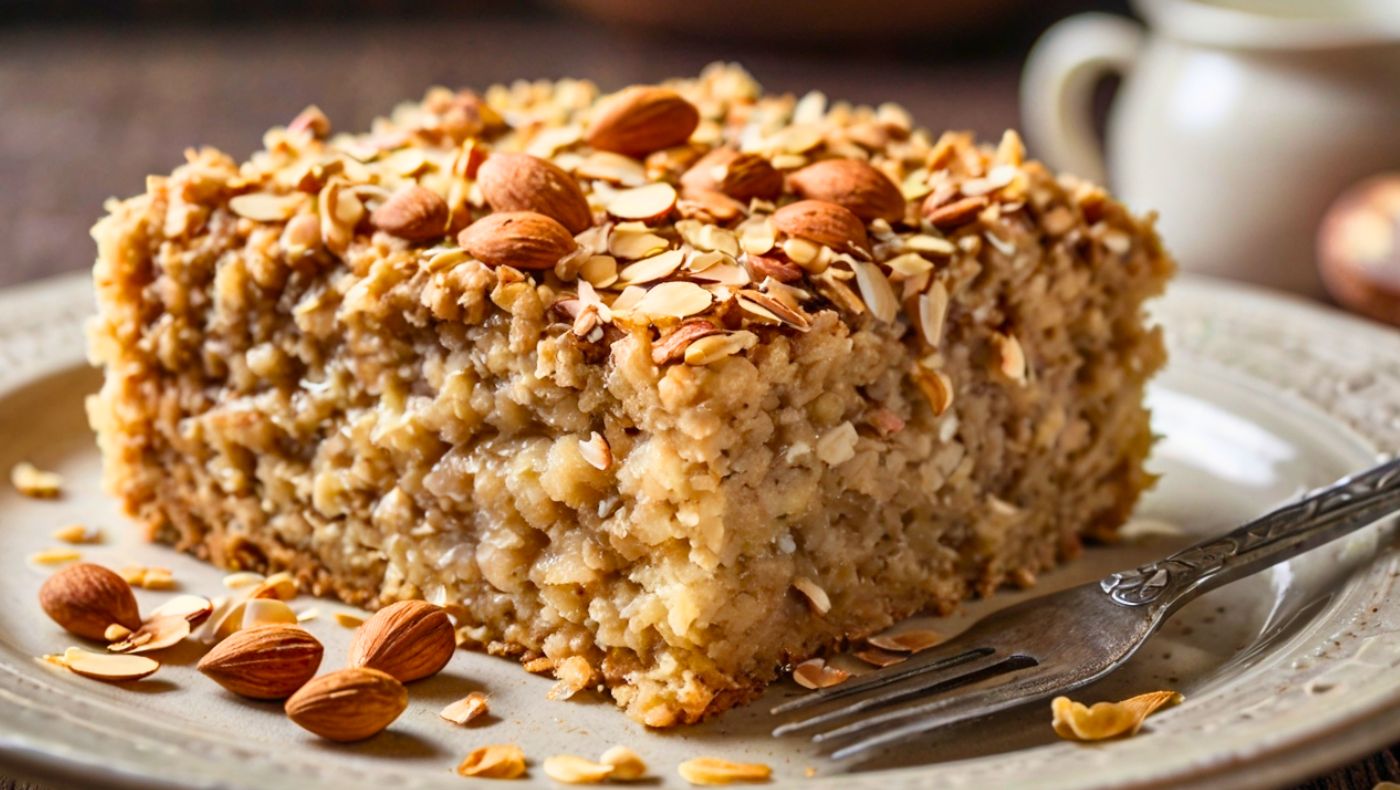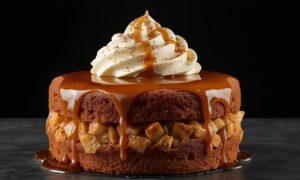“Is it cake time yet?” That was my daily question as a child whenever the cozy, sweet aroma of Grandma’s Oatmeal Cake floated from the kitchen. That scent warm cinnamon, brown sugar, and toasted coconut meant something special was happening. It meant comfort. It meant love. Grandma’s Oatmeal Cake wasn’t just dessert; it was a hug in every slice. Simple ingredients and old fashioned charm make this cake timeless.
You won’t find flashy frostings or fancy techniques here. Instead, you’ll discover a rich, moist cake. I make it with soaked oats, soft brown sugar, and a buttery coconut pecan topping that caramelizes beautifully under the broiler. It’s rustic, honest, and full of flavor. The texture is perfectly soft. The sweetness hits just right. And that golden, crunchy top? Pure magic.
In this post, I’ll show you how to make Grandma’s Oatmeal Cake the traditional way. We’ll talk about what makes it so moist. I’ll explain how to get that perfect topping. You’ll learn how to make it ahead for guests or cozy nights in. I’ll show you why soaking the oats matters. You’ll discover how to balance the warm spices and bring out the deep flavor that makes this cake a family favorite.
Grandma’s Oatmeal Cake delivers whether you’re craving nostalgia or starting a new tradition. It’s simple, satisfying, and loaded with character. Once you taste it, you’ll understand why this humble cake continues to win hearts, one bite at a time.
The Secret Behind This Grandma’s Oatmeal Cake Recipe
Grandma’s Oatmeal Cake gets its magic from smart baking science, not just nostalgia. When you pour boiling water over rolled oats, you create a moisture system that keeps this cake tender for days. The oats absorb water and swell up. This creates an almost custard like texture that makes every bite satisfying.
I combine brown sugar and white sugar for good reason. Brown sugar contains molasses. This attracts moisture from the air and prevents the cake from drying out. The broiled coconut pecan topping creates flavor layers through caramelization. Regular baking simply can’t achieve this depth.
like home. It feels like a warm hug. And it creates memories that last a lifetime.
Ingredients & Substitutions
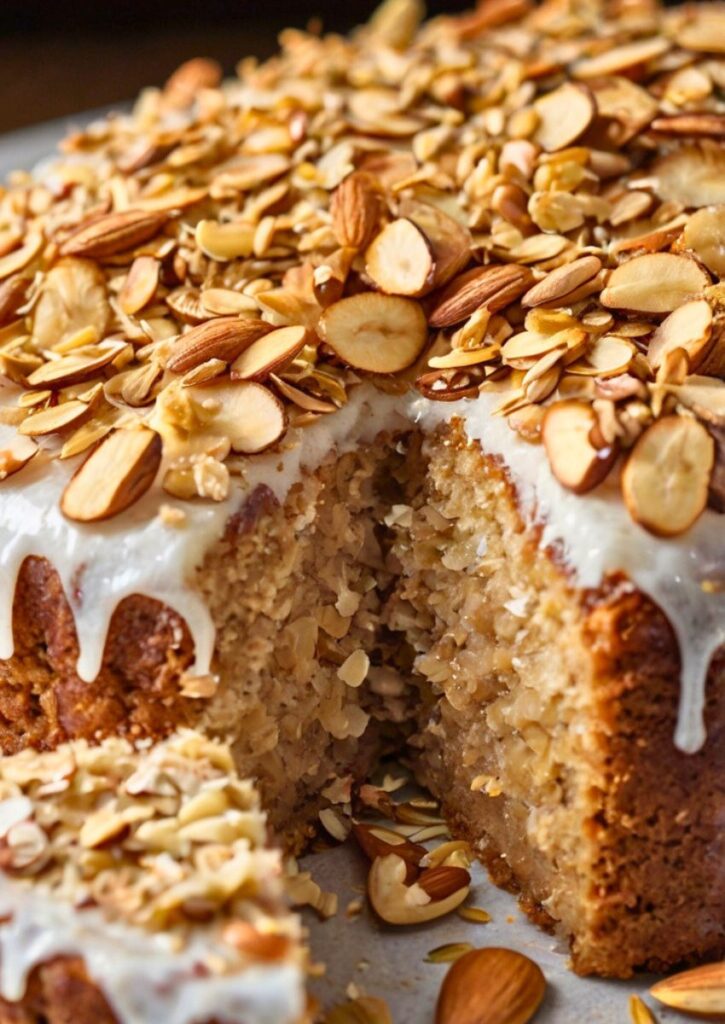
Professional bakers know that traditional oatmeal cake draws its beauty from simplicity, but each ingredient plays a crucial role that deserves professional consideration.
For the Cake Base:
- 1 cup old fashioned rolled oats (never instant)
- 1¼ cups boiling water
- ½ cup unsalted butter, room temperature
- 1 cup packed light brown sugar
- ½ cup granulated sugar
- 2 large eggs
- 1⅓ cups all purpose flour
- 1 teaspoon baking soda
- ½ teaspoon salt
- 1 teaspoon ground cinnamon
- ½ teaspoon freshly grated nutmeg
For the Legendary Broiled Topping:
- ½ cup unsalted butter
- ⅔ cup packed light brown sugar
- ⅓ cup heavy cream
- ¾ cup sweetened shredded coconut
- ¾ cup chopped pecans
- Pinch of sea salt
The oats are non negotiable old fashioned rolled oats provide the structural integrity and chewy texture that defines this cake. Steel cut oats won’t hydrate properly, while instant oats turn to mush and destroy the textural contrast we’re after. If you absolutely must substitute, quick oats can work in a pinch, but reduce the boiling water to 1 cup.
Brown sugar isn’t just about sweetness here; it’s about moisture retention and that deep molasses flavor that complements the nuttiness of the oats. Light brown sugar provides the perfect balance, but dark brown sugar works if you prefer a more assertive molasses note. Never substitute white sugar entirely you’ll lose the cake’s characteristic depth.
The flour choice matters more than most realize. All purpose flour provides just enough protein structure without creating a tough crumb. Cake flour makes the texture too delicate for the hearty nature of this dessert, while bread flour creates an unpleasantly chewy result.
For dietary adaptations, coconut oil can replace butter in a 1:1 ratio, though you’ll lose some richness. Gluten free flour blends work surprisingly well here the oats provide enough structure to mask any textural deficiencies. For egg free versions, each egg can be replaced with ¼ cup applesauce, though the cake will be slightly more dense.
Step by Step Instructions
Preparing the Oat Base
Start by preheating your oven to 350°F and greasing a 9×13 inch pan thoroughly. This isn’t the time to be stingy with the butter oatmeal cake has a tendency to stick if you’re not generous with the pan preparation.
Place your rolled oats in a medium bowl and pour the boiling water over them. Stir once to ensure all oats are moistened, then set aside for exactly 20 minutes. This timing is critical too short and the oats won’t fully hydrate; too long and they become mushy. The mixture should look like thick porridge when ready.
While the oats soak, cream your room temperature butter with both sugars until the mixture is genuinely fluffy about 4-5 minutes with a stand mixer. Many home bakers under cream this step, but proper aeration here creates the cake’s tender structure. The mixture should be noticeably lighter in color and increased in volume.
Beat in eggs one at a time, ensuring each is fully incorporated before adding the next. The mixture might look slightly curdled at this point don’t panic, it’ll come together.
Building the Batter
In a separate bowl, whisk together flour, baking soda, salt, cinnamon, and nutmeg. The key here is thorough distribution any pockets of baking soda will create unpleasant metallic flavors.
Add the hydrated oats to your creamed mixture, stirring just until combined. The batter will look unusual at this point almost lumpy and thick. This is exactly what you want.
Gradually fold in your dry ingredients, mixing just until you no longer see streaks of flour. Overmixing develops gluten, creating a tough cake that defeats the entire purpose of this comfort dessert.
Pour the batter into your prepared pan, spreading it evenly with an offset spatula. The surface doesn’t need to be perfectly smooth slight irregularities actually help the topping adhere better later.
The Baking Process
Bake for 35-40 minutes, until a toothpick inserted in the center comes out with just a few moist crumbs clinging to it. The top should be golden brown and spring back lightly when touched.
Here’s where many bakers go wrong they either underbake (leaving the center gummy) or overbake (creating a dry, crumbly result). The cake is done when the edges just begin to pull away from the pan sides.
Creating the Signature Topping
While the cake bakes, prepare your broiled topping. In a medium saucepan, melt butter over medium heat. Stir in brown sugar and cream, cooking until the mixture bubbles vigorously for about 2 minutes. Remove from heat and stir in coconut, pecans, and salt.
The moment your cake tests done, remove it from the oven and immediately spread the topping evenly across the surface. Work quickly the residual heat helps the topping adhere properly.
Switch your oven to broil and position the rack about 6 inches from the heating element. Broil for 2-3 minutes, watching constantly, until the topping is golden brown and bubbling. The coconut should be deeply toasted, and the pecans fragrant.
Cooking Techniques & Science
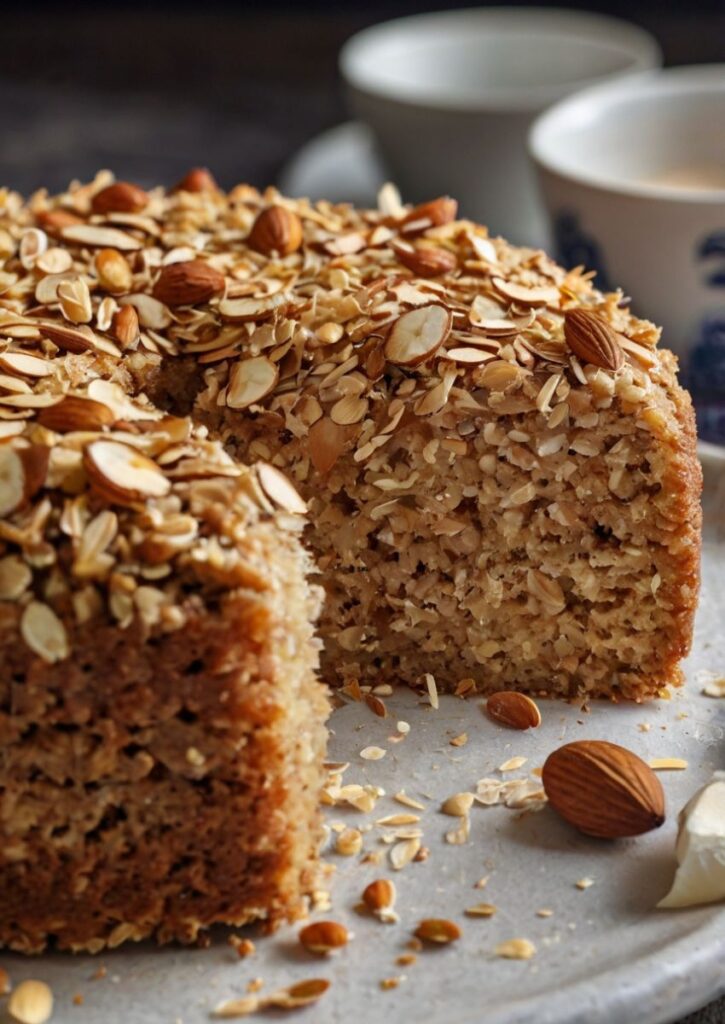
The magic of Grandma’s oatmeal cake lies in understanding how oats behave under heat and moisture. When you soak rolled oats in boiling water, the starch granules swell and partially gelatinize, creating a gel like structure that retains moisture throughout the baking process.
This pre hydration step serves multiple purposes beyond simple softening. It prevents the oats from drawing moisture from the surrounding batter during baking, which would create dry pockets. It also allows the oats to integrate more seamlessly into the final texture, rather than remaining as distinct, chewy pieces.
The combination of brown and white sugars isn’t arbitrary either. Brown sugar contains molasses, which is hygroscopic meaning it attracts and retains moisture from the environment. This keeps the cake tender for days longer than it would with white sugar alone.
The broiled topping represents a brilliant use of the Maillard reaction the complex chemical process that creates deep, nutty flavors when proteins and sugars are exposed to high heat. The brief, intense heat of broiling caramelizes the sugars while toasting the coconut and pecans, creating layers of flavor that couldn’t be achieved through regular baking alone.
Temperature control is crucial throughout this process. The initial baking temperature of 350°F is hot enough to set the structure without creating a tough crust that would prevent proper rise. The high heat of broiling at the end creates textural contrast a crispy, caramelized surface over the tender cake beneath.
Serving & Pairing Suggestions
Grandma’s Oatmeal Cake showcases remarkable versatility in its presentation possibilities. Serve it warm from the oven as a comforting end to a heavy meal. At room temperature, it makes an excellent coffee cake for brunch gatherings.
For elegant presentation, cut the cake into neat squares and dust lightly with powdered sugar. The contrast between the rustic topping and refined plating creates visual interest without compromising the dessert’s homestyle appeal.
This cake pairs beautifully with vanilla ice cream or fresh whipped cream the cool, creamy elements balance the rich, nutty flavors perfectly. For a more sophisticated approach, try serving it with a small dollop of crème fraîche or mascarpone.
Coffee is the natural beverage pairing, but consider how different brewing methods complement the cake’s flavors. A bold French press coffee enhances the nutty notes, while a smooth cold brew provides pleasant contrast. Tea drinkers should reach for robust black teas Earl Grey’s bergamot notes particularly complement the cinnamon and nutmeg.
For wine pairings, consider dessert wines with enough acidity to cut through the richness. A good Moscato or late harvest Riesling works wonderfully, as does a quality port or sherry.
Troubleshooting & Variations
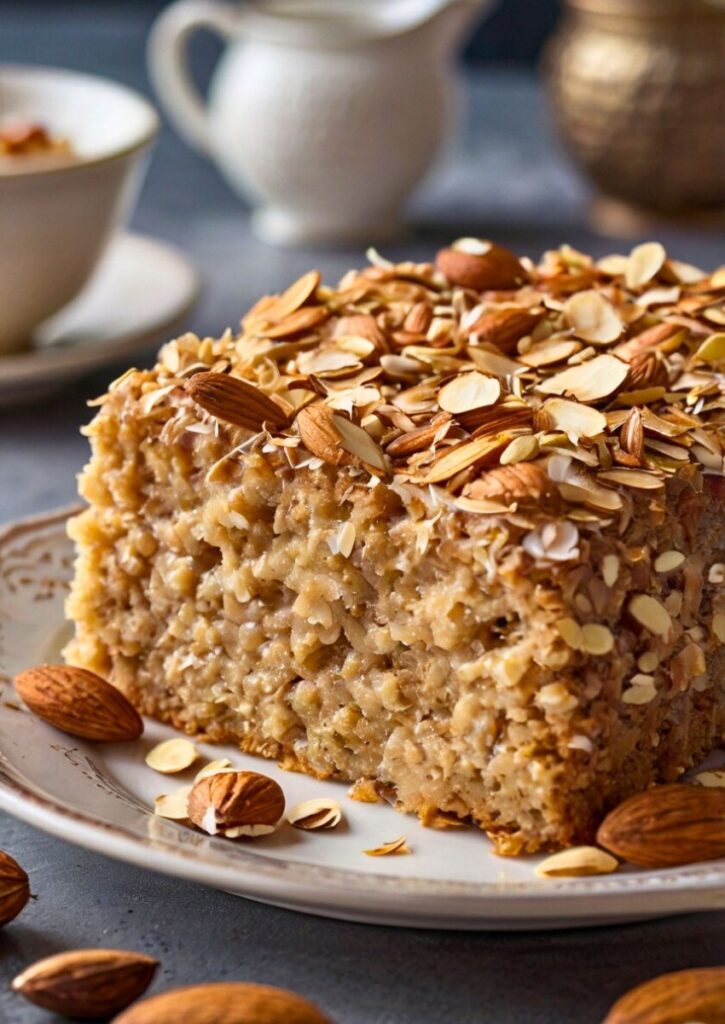
The most common issue with oatmeal cake is achieving the proper moisture balance. If your finished cake seems dry, you likely either over baked it or didn’t allow the oats sufficient soaking time. Dense, gummy texture usually indicates over mixing or using the wrong type of oats.
For those wanting to experiment, this base recipe accepts variations beautifully. Substitute half the all purpose flour with whole wheat for nuttier flavor and denser texture. Add ½ cup of chopped apples or pears for moisture and subtle fruit notes. A handful of raisins or dried cranberries provides textural interest and tartness.
The topping can be customized as well. Substitute chopped walnuts for pecans, or try a mixture of both. Mini chocolate chips added to the warm topping create an indulgent variation that’s particularly popular with younger palates.
For those avoiding coconut, simply increase the nut quantity to compensate for the lost texture and sweetness.
Conclusion
Grandma’s Oatmeal Cake represents everything beautiful about American baking tradition the transformation of humble ingredients into something extraordinary through technique and understanding. This isn’t just another cake recipe; it’s a lesson in moisture management, flavor layering, and the kind of comfort that only comes from food made with genuine care.
The brilliance lies not in complexity but in the careful orchestration of simple elements. The pre hydrated oats, the dual sugar system, the broiled topping each component serves a specific purpose in creating the final result’s distinctive character.
Whether you’re a professional baker looking to add comfort classics to your repertoire or a home cook wanting to master a family favorite, understanding the science behind Grandma’s Oatmeal Cake will elevate your baking game considerably. This cake proves that the most memorable desserts often come from the deepest traditions, where every technique has been refined through generations of loving preparation.
Frequently Asked Questions about Grandma’s Oatmeal Cake
Can I make this cake ahead of time?
Absolutely! Grandma’s Oatmeal Cake actually improves overnight as the flavors meld and moisture distributes evenly. Store covered at room temperature for up to three days, or refrigerate for up to a week. The broiled topping may soften slightly, but the flavor remains excellent.
Why did my topping burn under the broiler?
Broiler heat varies between ovens, and coconut burns quickly. Start checking after just 90 seconds and adjust your rack position if needed. If your broiler runs hot, try broiling for shorter intervals until you achieve the desired golden color.
Can I freeze this cake?
Yes, but with considerations. The cake itself freezes beautifully for up to three months when well wrapped. However, the coconut topping can become soggy upon thawing. For best results, freeze without the topping and add it after thawing and reheating.
What’s the difference between using quick oats versus old fashioned oats?
Old fashioned oats maintain their texture better during soaking and baking, providing the characteristic chewy elements that define this cake. Quick oats break down more completely, creating a smoother but less interesting texture.
My cake turned out dense. What went wrong?
Dense texture usually results from over mixing the batter once flour is added, or from using oats that were soaked too long and became mushy. Fold ingredients just until combined, and stick to the 20 minute soaking time for optimal results.

Swiftly Captions by Tina Smith — Quick, flavorful food recipes made simple, bringing fresh inspiration to your kitchen every day
